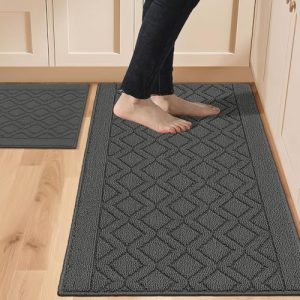When planning your kitchen, one question often comes up: how much space should you leave next to your kitchen sink and dishwasher? Getting this right can make your daily chores easier and your kitchen flow smoother.
If you’ve ever struggled with cramped counters or awkward appliance placement, this guide is for you. Keep reading to discover the ideal spacing that will save you time, reduce stress, and make your kitchen more enjoyable to use every day.
Recommended Space Between Sink And Dishwasher
Finding the right space between your kitchen sink and dishwasher is key to making your kitchen both functional and comfortable. The gap you leave affects how easily you can load dishes, manage water splashes, and keep your workflow smooth. Let’s break down the recommended distances that balance practicality with efficiency.
Minimum Clearance Guidelines
At the very least, allow for a clearance of 18 inches between the sink and dishwasher. This space prevents water from splashing onto the dishwasher door and gives you enough room to open both the sink cabinet and dishwasher comfortably.
Anything less than 18 inches can make tasks feel cramped and awkward, especially when you’re multitasking with dishes and utensils.
Ideal Distance For Convenience
A distance of 24 inches is generally ideal for most kitchens. This range gives you enough counter space to place dishes temporarily and makes transferring items from the sink to the dishwasher easier.
Think about your daily routine—do you often rinse and stack dishes? Having a wider gap means you can set plates down without worrying about crowding or knocking things over.
Impact On Workflow Efficiency
The space between your sink and dishwasher directly affects how smoothly your kitchen functions. Too little space slows you down and increases the risk of spills. Too much space means extra steps and wasted motion.
Finding the right balance reduces fatigue and keeps your kitchen flow natural. Have you noticed how a small adjustment in layout can save you minutes every day?
Standard Kitchen Sink Dimensions
Understanding standard kitchen sink dimensions is key to planning a functional and comfortable kitchen space. The size and shape of your sink affect not only how much countertop space you have next to it but also how efficiently you can work. Knowing these dimensions helps you decide the ideal amount of space to leave next to your sink and dishwasher, ensuring smooth workflow and convenience.
Common Sizes And Shapes
Kitchen sinks come in a range of sizes, but most standard sinks measure between 22 to 33 inchesin width. Depth usually falls within 18 to 22 inches. The most common shapes include:
- Rectangular:Offers maximum usable space and fits well into standard countertops.
- Round or Oval:Stylish but often provides less usable area, which might affect adjacent space planning.
- Double Bowl:Popular for multitasking, typically wider and requires more countertop space.
Choosing a sink that fits your kitchen’s layout is essential. If your space is tight, a smaller rectangular or single bowl sink might work best. Have you checked if your current countertop allows for these common sizes?
Depth And Bowl Configuration
Sink depth varies, usually between 7 to 10 inches. Deeper sinks are great for washing large pots but can be harder to reach into for some users. Bowl configurations affect how you use the sink:
- Single Bowl:Offers a large, uninterrupted space, perfect for washing big items.
- Double Bowl:Lets you separate tasks, like washing and rinsing, but splits the available space.
- Triple Bowl:Less common, but useful if you multitask heavily in the kitchen.
Think about your daily kitchen routine. Do you wash many large dishes, or do you prefer separating prep and cleaning areas? This choice impacts how much space you’ll want next to your sink and dishwasher to keep everything accessible and organized.
Typical Dishwasher Sizes
Choosing the right dishwasher size is crucial for a functional kitchen. It ensures efficient space utilization and smooth workflow. Dishwashers come in various sizes to fit different kitchen layouts. Understanding these sizes helps in planning kitchen space effectively.
Standard And Compact Models
Standard dishwashers are typically 24 inches wide. They are suitable for larger kitchens with ample space. Compact models are about 18 inches wide. These are ideal for smaller kitchens or apartments.
Both models offer similar features. Compact models hold fewer dishes. They are still efficient and save space.
Built-in Vs Portable Options
Built-in dishwashers are permanently installed under countertops. They integrate seamlessly with kitchen designs. These models require dedicated space and plumbing.
Portable dishwashers are versatile. They can be moved and stored when not in use. These are great for kitchens with limited space. Portable models connect to kitchen faucets when needed.
Choosing between built-in and portable depends on your kitchen layout. Consider your available space and installation preferences.
Ergonomics And Accessibility
Ergonomics and accessibility are crucial when planning the space next to your kitchen sink and dishwasher. Proper spacing helps reduce strain and makes daily tasks easier. It ensures you can work comfortably and safely, no matter your kitchen layout or who’s using it.
Comfortable Reach Zones
Your sink and dishwasher should be within easy reach to avoid unnecessary bending or stretching. Ideally, keep frequently used items like soap, sponges, and towels within 15 to 20 inches of the sink. This allows smooth, natural movements while washing dishes or prepping food.
Think about your own habits. Do you often find yourself stretching awkwardly for the dishwasher door or soap dispenser? Adjusting the layout to fit your comfortable reach zone can save you from daily frustration.
Avoiding Obstructions
Space next to the sink and dishwasher must be free from obstructions. Cabinets, drawers, or trash bins that block access can make simple tasks cumbersome. Leave at least 24 inches of clear countertop space on one side of the sink for prep work and dish stacking.
Also, consider the dishwasher door swing. Make sure it won’t hit cabinets or appliances when open. This small detail can prevent accidents and make loading dishes much easier.
Considerations For Different Users
Not everyone in your home will have the same reach or mobility. If children or elderly family members use the kitchen, adjust the sink and dishwasher space accordingly. Lowering countertops or installing pull-out shelves can improve accessibility.
Ask yourself: Is the space adaptable for guests or future needs? Designing with flexibility means everyone can use the kitchen comfortably and safely. Think about how your kitchen will work for everyone, not just yourself.
Plumbing And Electrical Considerations
Plumbing and electrical work shapes how much space you need next to your kitchen sink and dishwasher. Proper setup avoids leaks, electrical hazards, and appliance issues. Planning these details early helps keep your kitchen functional and safe.
Placement Of Water Lines
Water lines must be close to the sink and dishwasher. The cold and hot water pipes connect to both appliances. Keep space around pipes for easy access and repairs. Avoid tight spots that make installation hard or cause leaks.
Drainage Requirements
Drain pipes need enough room to slope correctly for water flow. The dishwasher drain usually connects to the sink drain. Space must allow a trap to prevent sewer gases from entering your kitchen. Proper drainage stops water backup and damage.
Power Outlet Positioning
Electrical outlets must be near the dishwasher but away from water sources. Outlets should be grounded and follow local codes. Position outlets above the counter or behind the dishwasher for safety. Ensure space for cords without stretching or bending.
Design Tips For Small Kitchens
Designing a small kitchen comes with unique challenges, especially when planning the space around your sink and dishwasher. Every inch counts, and the goal is to create a functional area without feeling cramped. You want to make sure your kitchen works for you, not the other way around.
Maximizing Space Efficiency
Think about the space next to your sink and dishwasher as prime real estate. Leave at least 18 inches of countertop next to the sink for prep work and drying dishes. This prevents clutter and keeps your workflow smooth.
Use vertical storage like wall-mounted racks or magnetic strips for utensils and knives. This frees up counter space and keeps essentials within easy reach. Have you considered pull-out shelves inside cabinets? They make accessing cleaning supplies under the sink easier without wasting space.
Alternative Layouts
If a traditional kitchen layout feels tight, try rearranging appliances to open up space. Placing the dishwasher on the opposite side of the sink might create more countertop area where you need it most. You can also experiment with corner sinks to utilize awkward spaces effectively.
Think about whether a galley or L-shaped layout could better suit your kitchen’s footprint. Sometimes shifting the dishwasher near the dining area can speed up cleanup and keep traffic flow uninterrupted. How could changing your layout improve daily tasks?
Multi-functional Areas
Small kitchens benefit from surfaces that serve more than one purpose. Consider a countertop next to the sink that doubles as a chopping board or a drying rack. This saves space and speeds up meal prep.
Install a fold-down counter extension beside the dishwasher to create extra workspace when needed. You can also use the space above the dishwasher for open shelves to store frequently used items. What multi-use features would make your kitchen more efficient?
Common Mistakes To Avoid
Getting the space right next to your kitchen sink and dishwasher is more important than most people realize. Small mistakes here can cause big headaches, from cramped areas to appliances that don’t work well together. Avoiding common pitfalls will save you time, money, and frustration during your kitchen setup or remodel.
Insufficient Clearance Issues
One of the biggest mistakes is not leaving enough clearance between the sink and dishwasher. Without proper space, opening dishwasher doors can block access to the sink or cabinet. It also makes it harder to load and unload dishes efficiently.
Think about how you use your kitchen daily. Do you want to awkwardly squeeze between appliances or have room to move freely? A good rule is to allow at least 2 to 3 inches of clearance to prevent crowding.
Ignoring Appliance Specifications
Each dishwasher and sink model has specific size and installation requirements. Skipping these details can lead to improper fitting or damage. For instance, some dishwashers need extra space for door swings or water connections that might not be obvious at first glance.
Have you checked the manuals or manufacturer guidelines before planning your space? This step is often overlooked but can make all the difference in a smooth installation.
Poor Workflow Design
Setting your sink and dishwasher too close or too far apart disrupts your kitchen workflow. Imagine washing dishes and then having to carry them across the room to load the dishwasher—it’s inefficient and tiring.
Arrange these appliances so you can move naturally between tasks. A well-planned layout improves your kitchen’s flow and makes daily chores easier. How could a small change in spacing improve your cooking and cleaning routine?
Frequently Asked Questions
How Much Space Should Be Left Next To A Kitchen Sink?
Leave at least 18 to 24 inches of counter space next to the kitchen sink. This space allows for food prep and dish drying. It also provides room for cleaning supplies and makes the kitchen more functional.
What Is The Ideal Gap Between Dishwasher And Sink?
The ideal gap between dishwasher and sink is about 2 to 3 inches. This small space helps with installation, plumbing access, and prevents water damage. It also ensures easy loading and unloading of dishes.
Why Is Space Next To Kitchen Sink Important?
Space next to the kitchen sink is crucial for convenience and hygiene. It offers a spot for drying dishes, food prep, and storing cleaning tools. Adequate space reduces clutter and improves kitchen workflow.
Can Dishwasher Be Installed Right Next To The Sink?
Yes, dishwashers can be installed right next to the sink. A small gap of 2 to 3 inches is recommended for plumbing and maintenance access. This placement enhances efficiency by minimizing water line length.
Conclusion
Planning the right space next to your kitchen sink and dishwasher helps a lot. It makes washing dishes easier and keeps your kitchen neat. Leaving about 18 inches between them gives you enough room to work. Small gaps can cause discomfort or mess.
Giving enough space also helps with cleaning and maintenance. A well-spaced kitchen feels more open and comfortable. Remember, simple changes improve daily kitchen use. Think about space early, and your kitchen will work better every day.

Sophie Hartwell is the founder of KitchenQuik.com, where she shares kitchen tips, smart cooking hacks, and the best product picks to make everyday cooking easier and more enjoyable.




